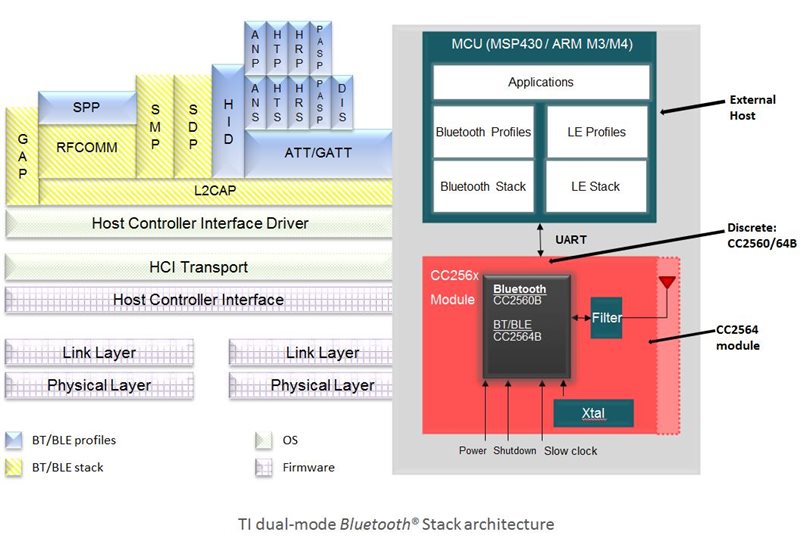SSZTCB8 august 2015 CC2560 , CC2564 , CC2564MODN
Whether you studied engineering, or just work with electronics as a hobby, everyone has their go-to devices and software for projects. With wireless connectivity integrated into most technology today, we find that our projects are integrating Bluetooth® classic and low energy more and more, such as streaming music from a phone to headset wirelessly or sending quick data from a heart rate monitor. On the market today there are so many options when it comes to working with Bluetooth that choosing the correct one can be daunting, especially when the available profiles, protocols, reliability and performance have to be taken into consideration. TI’s dual-mode Bluetooth stack offers versatile and stress-free software to start using Bluetooth in any project from a wireless sprinkler system to a portable Bluetooth speaker, that you will never need another software development kit (SDK) for Bluetooth.
Most Flexible
Most stacks are developed for a specific host, greatly limiting the ability one has when creating, developing and innovating with Bluetooth. It requires buying a new microcontroller (MCU) to start a Bluetooth project, as well as the learning time that comes by working with a new MCU and being limited by the its ability. The TI dual-mode Bluetooth stack provides complete flexibility to all end users. The software works with all CC256x devices (CC2560, CC2564 and CC2564MODN) providing both classic and low energy Bluetooth profiles. However, what really sets this stack apart is that it works with a large range of MCUs, allowing users to choose their favorite microcontroller or the one best suited for their project. The TI dual-mode Bluetooth stack offers three software development stacks: our ultra-low-power MSP430™ MCUs, TM4C MCUs and also on the STM32F4 MCUs. These development stacks not only provide sample applications, but can be configured to work with a large range of MCUs.
Fast-to-market Functionality
In today’s world we want everything fast and TI’s dual-mode Bluetooth stack does just that. The TI Bluetooth stack is certified by the Bluetooth Special Interest Group (SIG) as a host subsystem and profile subsystem (QDID 69887 and QDID 69886). This means that the Bluetooth device is ready to use the moment the software finishes installing.
Need a specific setup of profiles for your project? TI provides a wide range of device options (CC2560, CC2564 and CC2564MODN) to pick the ones you need, with the option to select or turn off the profiles you want running in your system. The TI dual-mode Bluetooth stack provides the same offering across all the platforms, so any setup can be run across any supported MCU (MSP430, TM4C or STM32F4) and TI dual-mode Bluetooth device (CC2560, CC2564 and CC2564MODN) combination. With a wide range of available profiles, from the common Advanced Audio Distribution Profile (A2DP) to Health Thermometer Profile (HTP), there is no limit to what can be created!
Outstanding Performance
How do we know that TI’s dual-mode Bluetooth stack has exceptional performance? The stack is a pre-integrated solution, meaning integration is easier to use than other stacks. There has been an extensive amount of testing on the available platforms’ software, ensuring the stacks robustness and reliability while still providing optimal performance. With TI's ongoing investment in Bluetooth solutions and commitment to provide faster development cycles for our customers, TI has taken over full support of the Bluetooth stack that is based on the Bluetopia® stack software for customers using key TI platforms. Should you have a question, you can turn to TI as the one Bluetooth solutions resource. What guarantees outstanding performance is that TI continues to update its features and profiles. With just one click on the ALERT ME button on a SDK offering download page, users will receive emails notifying them of new updates.
The flexibility, fast-to-market functionality and outstanding performance of the stack makes the TI dual-mode Bluetooth stack the perfect SDK for any project. Build your unique individual solution for your specific project from a vast list of classic and low energy profiles. What will you create with the Bluetooth stack?
For more information visit the TI dual-mode Bluetooth stack page and check out the following available documentation:
- TI dual-mode Bluetooth stack wiki: For available profiles and demonstration
- The user guides for the ultra-low power MSP430 MCUs, TM4C MCUs and other MCUs
- The download link for the certified and royalty free software: for ultra-low-power MSP430™ MCUs, TM4C MCUs and STM32F4 MCUs
